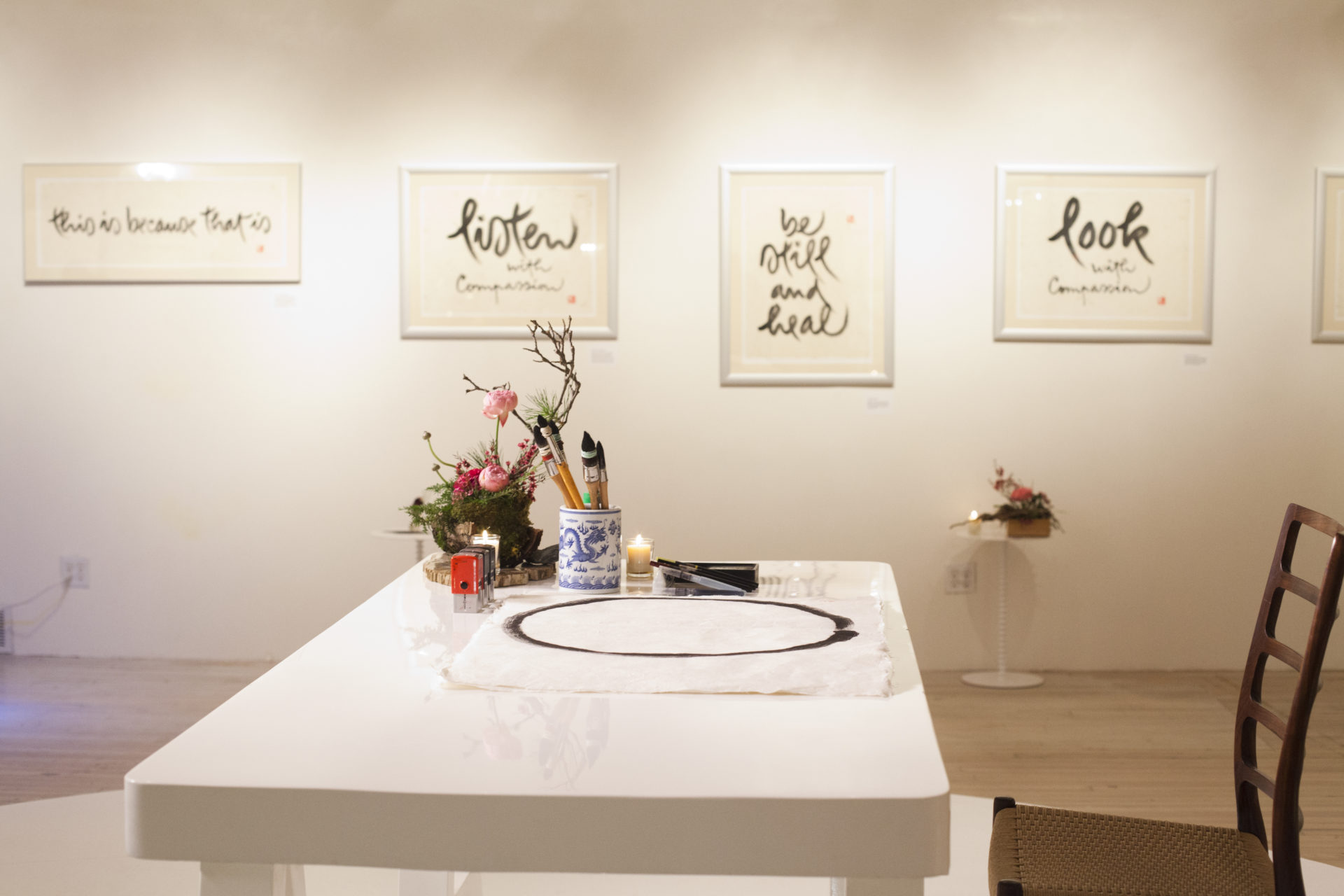An Interview with Anh-Huong Nguyen
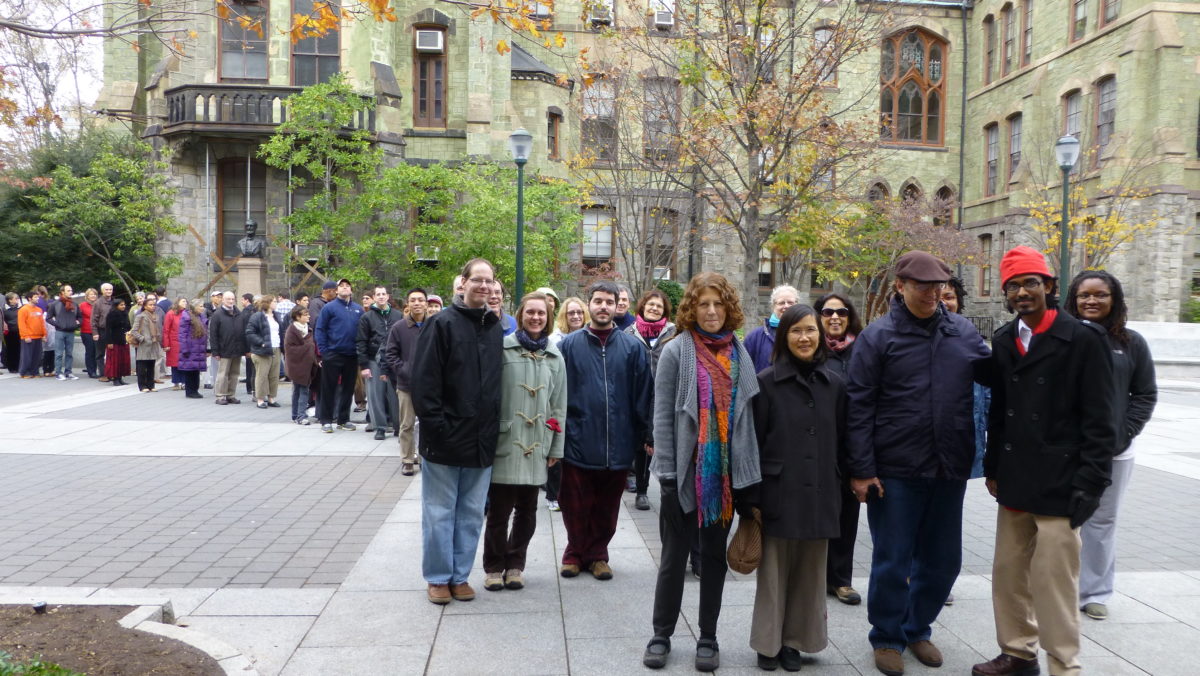
Anh-Huong Nguyen has been practicing mindfulness in the tradition of Zen master Thich Nhat Hanh for more than thirty years. She has led mindfulness retreats in the United States since 1988, and in 1992 was among the first students to be ordained as meditation teachers by Thich Nhat Hanh.
An Interview with Anh-Huong Nguyen

Anh-Huong Nguyen has been practicing mindfulness in the tradition of Zen master Thich Nhat Hanh for more than thirty years. She has led mindfulness retreats in the United States since 1988, and in 1992 was among the first students to be ordained as meditation teachers by Thich Nhat Hanh. She and her husband, Thu Nguyen, founded the Mindfulness Practice Center of Fairfax, Virginia, in 1998. The center offers sessions of mindfulness training and practice in a nonsectarian way. MPCF (www.mpcf. org) is located in the beautiful, secluded setting of the Unitarian Universalist Congregation of Fairfax in Oakton, Virginia.
In a phone interview with Natascha Bruckner for the Mindfulness Bell in September 2013, Anh-Huong shared these stirring Dharma teachings in a gentle but passionate voice.
The Mindfulness Bell: You’ve been practicing for many years in the Plum Village tradition. I’m curious to know how you started, especially how you first encountered Thich Nhat Hanh and what effect his teachings had on your life then.
Anh-Huong: I met Thay long ago, when I was still in my mom’s belly. My mom and dad came to Tan Son Nhat Airport in Saigon to say goodbye to Thay when he left Vietnam the first time, on a fellowship to study comparative religion at Princeton University. It was in the summer of 1961, when I had been in my mommy’s tummy for seven months.
When I was ten, while sitting in our living room, I picked up the book Hoa Sen Trong Bien Lua (Lotus in a Sea of Fire). On the back was a photograph of Thay pouring tea from a teapot. I felt very drawn to the photograph, so I looked at it for ten or fifteen minutes.
MB: What did you receive from the photograph? It sounds as if a transmission was happening.
AH: It’s hard to describe. I felt a sense of warmth and peace inside. I felt happy just looking at the photograph. It reminds me of Thay’s story about looking at the drawing of a Buddha on the cover of a Buddhist magazine when he was a boy.
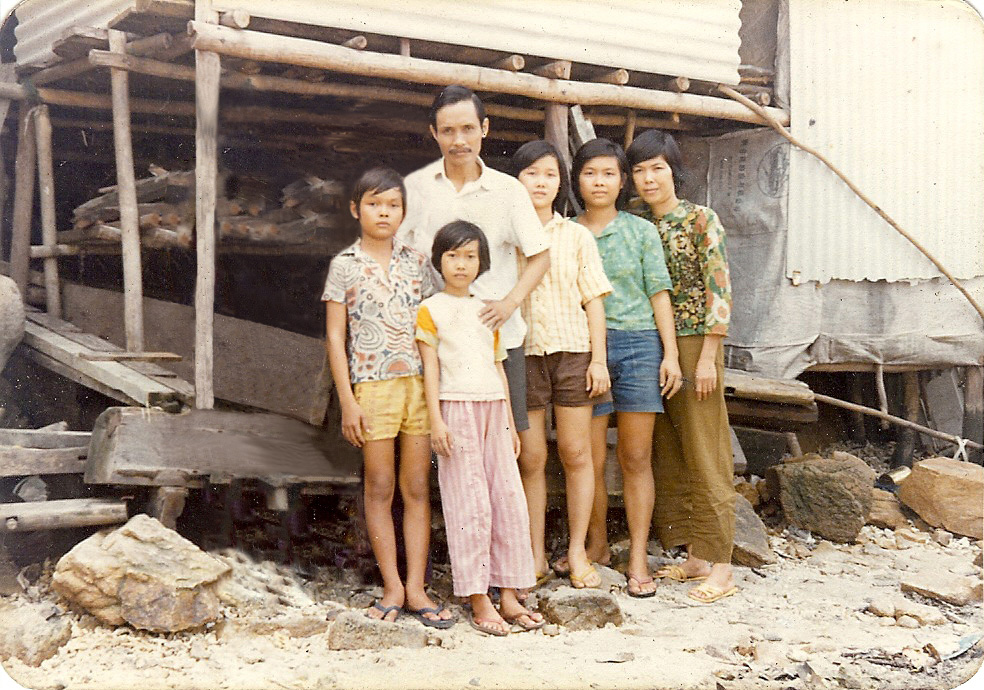
MB: When did you meet Thay in person?
AH: Our family escaped Vietnam in a small boat on February 14, 1979. We almost lost our lives several times on the sea because of high waves. We were moved around to several locations and finally settled in a big refugee camp on Pulau Bidong Island in Malaysia. Our family—my parents, my two younger sisters, and my younger brother—flew to Philadelphia on December 13, 1979. We were sponsored by a Catholic church and settled in Audubon, New Jersey.
About six months after that, I met Thay. I still vividly remember him giving me my first lesson on mindful breathing. He said, “Lie down, my child. Put your hands on your belly, and breathe.” That’s all! Not even, “Breathing in, I know I am breathing in; breathing out, I know I’m breathing out.”
I put my hands on my belly and began to feel my breath. My family was Buddhist. We prayed and chanted at home. Occasionally we went to the temple. But this was the first time I received direct teaching from a Buddhist monk. I found my breath. I was aware that something very important had just happened to me. The first lesson on mindful breathing stayed with me and sustained me from that point on.
We all studied hard in school. After high school, I went to Rutgers University. I had learned English when I was in Vietnam but it was still hard to understand and to speak. So when I began at Rutgers, I took a tape recorder with me and recorded some of the lectures. I listened to them again at home and if there were things I did not understand, I would be the first student waiting to ask the professor for clarification. I was very enthusiastic. I wanted to learn and to do well because in my heart, I wanted to go back to Vietnam and other places in the world to help in any way I could.
But, after the first exam during my first year, I lost interest in studying. I looked at the textbook but nothing would sink in. Only in recent years, I realized that I had been in depression. I missed home so much; I missed my friends. And I knew that the suffering was still going on in my homeland.
In my heart there was an urgency to do something to help. I could not go back to Vietnam or to the refugee camp. I felt helpless and paralyzed. Despair built up inside me. But I still had to study. My parents were working hard to support us so we could focus on our studies. As the eldest, I had to set a good example for my younger sisters and brother. But my heart and my mind were still in Vietnam, which pulled me away from my desire to study. As I say these words, I have so much compassion for this nineteen-year-old girl in me.
A True Rebirth
MB: What got you through that time?
AH: Mindful breathing and writing letters to Thay and Sister Chan Khong. Sister Chan Khong shared with me how she sent packages to poor families in Vietnam, so I started doing that. I sent packages to the families of some of my friends, especially those whose parents were put into reeducation camps because they worked for the old government.
Thay wrote to me and gave me an assignment. He said, “Write down all your conditions for happiness, all the things that you still have.” I started writing, and to my surprise, I ran out of paper. I was learning not to be so caught up in what I couldn’t do for the people in Vietnam and in the refugee camp. I cried and cried. Tears of awakening. Even before I finished the assignment, transformation already happened inside of me. I felt more present, peaceful, and happy. In fact, that assignment is not to be finished.
So I continued going to school and sending letters and packages to poor families in Vietnam. Sister Chan Khong taught me to use different names when sending the packages, so the communists wouldn’t question why one person was sending so many packages to so many families. I would use the family name as the sender, as if I were a member of that family.
In my letters, I tried to water the good seeds in them and encourage and comfort them. I shared about my life in the U.S., both the challenges and the beauty of what I encountered. Sometimes I wrote in the voice of a woman who was twenty years older than me, sometimes in the voice of a younger sister or brother. This work and mindfulness practice made it possible for me to have the balance I needed in order to continue my studies.
Sometimes when a big wave of despair suddenly came upon me, I could not go to class. It happened less and less as time went on. But when it did, I would choose to miss the lecture and walk through the campus. I did not know that I was doing walking meditation, but I was breathing and walking. I felt more relaxed, solid, and calm walking among the trees and flowers on the campus grounds. Then I would go to the next class.
The teaching on mindful breathing that was transmitted to me nourished and sustained me each day. I was told that Thay and Sister Chan Khong fasted one or two evenings a week because they wanted to remember the hungry children in Vietnam. I also decided to skip one meal each week. Small things like that helped me stay connected with those who were less fortunate and keep my heart warm.
We had survived the perilous trip by boat. It was a miracle that our family of six could make it to the States, to this “land of freedom,” in my dad’s words. My parents said that they would sacrifice everything in order to free their children from the communist regime. But the transmission I received from Thay and Sister Chan Khong was the most precious gift of all. It opened my eyes and my heart. I was reborn.
I was happy and grateful to be reborn. My deepest wish is to share this happiness with others. What happened to me when I was at Rutgers was a true rebirth. And since then, I have been born again and again. Each day, I continue to receive transmission from Thay and Sister Chan Khong, and I continue to pass it on to family and friends.
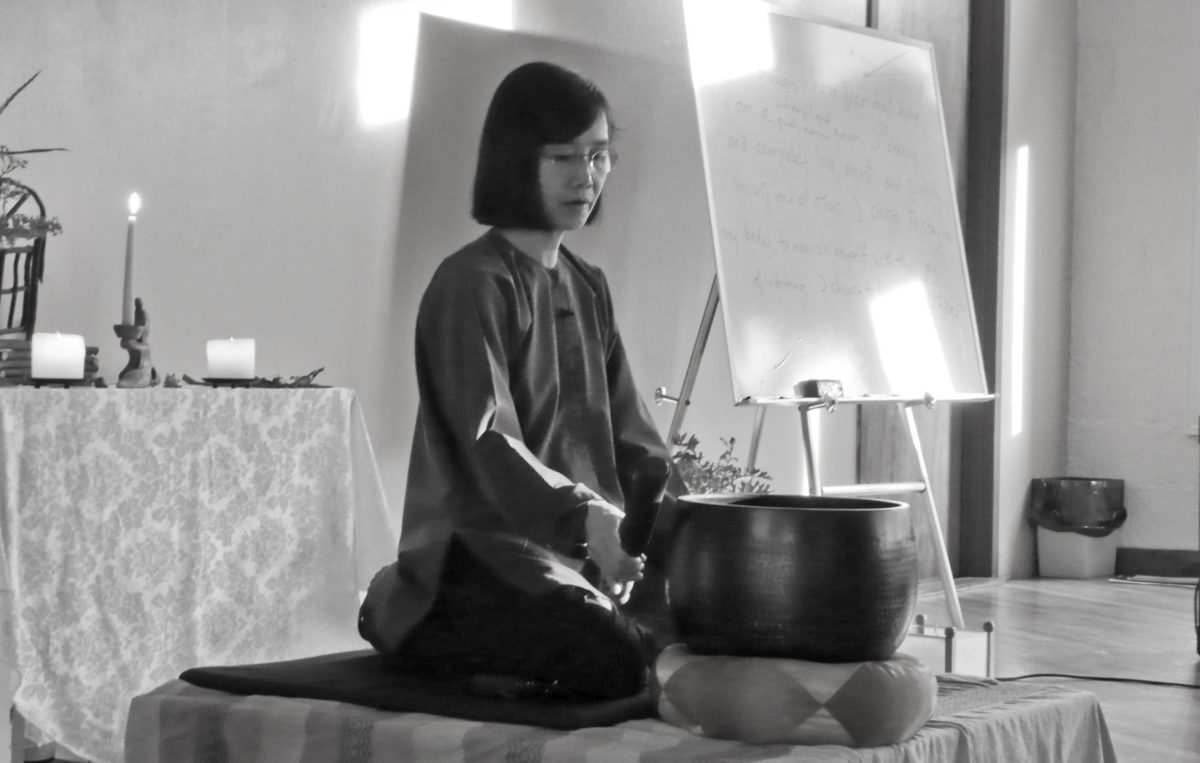
Sharing with Others
MB: I’m curious how you have shared that with others. Have you helped people to experience that kind of rebirth?
AH: My desire to share this practice springs from a deep well of gratitude. I share through Sangha building; the Sangha is the place through which I can share all of my life experiences.
My story from Rutgers is about maintaining a balance between being present with the pain arising in you, and at the same time embracing the joy of being alive. When our deepest desire is to understand the suffering that is there, mindfulness practice is not hard work. Each breath or each step taken in mindfulness is a pure delight. It is in the places where there is suffering that the practice of mindfulness becomes clear and alive––whether it is the practice of cultivating joy or transforming suffering. True healing and transformation cannot happen without insights. When we practice together as a Sangha, the collective energy of mindfulness and concentration is steady and strong, which becomes fertile soil for the ripening of seeds of insights.
The Sangha helps us to be present with our pain and to nourish joy and happiness in a way that no one individual can. We may learn how to breathe, walk, release tension in our bodies and minds, how to cultivate joy, and how to be there for a painful feeling. But sometimes our mindfulness is not strong enough to hold the pain that arises in us. We need to lay this pain inside the Sangha’s cradle, so that it can be held by the collective mindfulness and concentration.
When I was in New Jersey, I did not have a local Sangha to practice with. Although Thay and Sister Chan Khong were in Plum Village, I felt their presence in me. I was nourished and sustained each day by the teachings that they had transmitted to me. The trees and the birds and my friends at school were also part of my Sangha.
We need a Sangha in order to practice. Sangha is our refuge. Our pain is not only individual pain, but also ancestral pain, collective pain. Without a Sangha, it’s very difficult to embrace and transform this pain alone. And when we talk about building Sangha, we talk about building brotherhood and sisterhood.
MB: What does building brotherhood and sisterhood mean to you?
AH: Brotherhood and sisterhood are the substance of a true Sangha. When we can listen deeply to the stories of our Sangha brothers and sisters, we may be able to hear their ancestors and ourselves at the same time. Their stories are never theirs alone. The joy and pain that we share in the Sangha are held by the entire Sangha. When the discrimination between my pain and others’ pain is not there, the false separation between me and others disappears. Struggles that are shared in the Sangha circle can help us touch the pain that lies deep within, and our hearts may feel tender for the first time.
When I take care of a brother or sister in the Sangha, I take care of myself. When my Dharma sister or brother is in pain, I want to be there for the pain. It’s not my obligation as a Dharma teacher or a senior member of the Sangha. Building brotherhood and sisterhood, taking care of the Sangha, is taking care of myself. It’s taking care of my mother, my sister, my family. It’s natural. I see myself as a small segment of a long bamboo, and the ancestral teachers’ wisdom and compassion flow through the entire bamboo. The energy that runs through me and allows me to serve the Sangha is not really mine. My practice is to keep my segment hollow so that water from the source can pass through easily.
MB: To follow up on what you shared before––are you still sending packages to Vietnam, or are you currently engaged in supporting people there?
AH: I stopped sending packages to Vietnam after I was allowed to visit when the Vietnamese government loosened their travel policy. I visited the orphanages and the poor families. Now instead of sending packages, I send money. With the help of a number of friends, we started a non-profit organization, Committee for the Relief of Poor Children in Vietnam. People can send money to us, and twice a year we send it on to Vietnam to support several projects. You can learn more about the work we’re doing at www.crpcv.org. This work sustains me and sustains our Sangha. One member of our Sangha often brings vegetables from her garden to share, and the dana she receives goes to help the poor children in Vietnam.
MB: What helps you to sustain a connection with Thay, Sister Chan Khong, and the teachings?
AH: What sustains my connection with Thay and Sister Chan Khong as well as the Buddha and the Dharma is Sangha building. We are like trees that grow in the Sangha soil. Without the Sangha, we cannot grow beautifully and strongly. For me, the Sangha is everything. When I sit with my Dharma brothers and sisters, sharing stories, I feel all of our spiritual and blood ancestors are present with us. Whenever I take a walk or give a talk, Thay and my Sangha and all of my ancestral teachers are always with me.
MB: So there’s no reason to feel alone.
AH: I’ve never felt alone. Even in the most challenging times in our family and in the Sangha, I deeply trust that everything will be all right. We just need to allow ourselves to be carried in the stream of our ancestral teachers. I do not have to make any decisions or solve any problems alone. Thay, Sister Chan Khong, and all of our ancestors are doing everything with us. The Sangha is like a float. When we left Vietnam, my dad hung tires around our small boat. If he hadn’t done that, the boat would have sunk immediately as soon as we encountered high waves. For me, the Sangha is like those tires; it keeps us afloat.
The Sangha is a body. Some of us happen to be the head, some happen to be the belly, and some to be the feet. We are different parts of that body. A Dharma teacher is often perceived as Sangha leader, which can be a misperception. A Dharma teacher may belong to the head part of the Sangha body, but he or she does not have to be the leader. I or we do take care of the Sangha. But believing in the idea that there is an “I” or “we” who take care of the Sangha may take away the joy, freedom, and happiness of Sangha building. There’s taking care of the Sangha, but there’s no one who’s taking care of the Sangha.
MB: If someone has that perception of “I am taking care,” or “we are taking care of the Sangha,” how do you suggest that people work with that perception to open their minds?
AH: We are so conditioned to living, practicing, and helping in that way. When we walk in the mist, our shirt gradually gets wet. If there is one person in the Sangha who serves the Sangha without thinking that “I am taking care of the Sangha,” that spirit will penetrate into the entire Sangha. Building Sangha in the light of interbeing can bring us endless joy and freedom. People often say, “Oh, you’re an OI member, you have these responsibilities. You have to build Sangha. You have to do this and that.” Or, “As a Dharma teacher, you take on a lot more responsibility.” But I don’t feel that way because I never thought of myself as a Dharma teacher. [Laughs.]
Receiving Lamp Transmission from Thay or entering the core community of the Order of Interbeing can only help us feel more free and happy, because we are now entering the stream of our ancestral teachers. We should not let the “brown jacket” or the title “Dharma teacher” get in the way! If you’re happy, you are already a true Sangha builder. Responsibility is a wholesome trait, but when it is mixed with the notion, “I have to carry it,” then it becomes a burden, a source of unhappiness. We don’t have to carry anything. The Sangha carries everything.
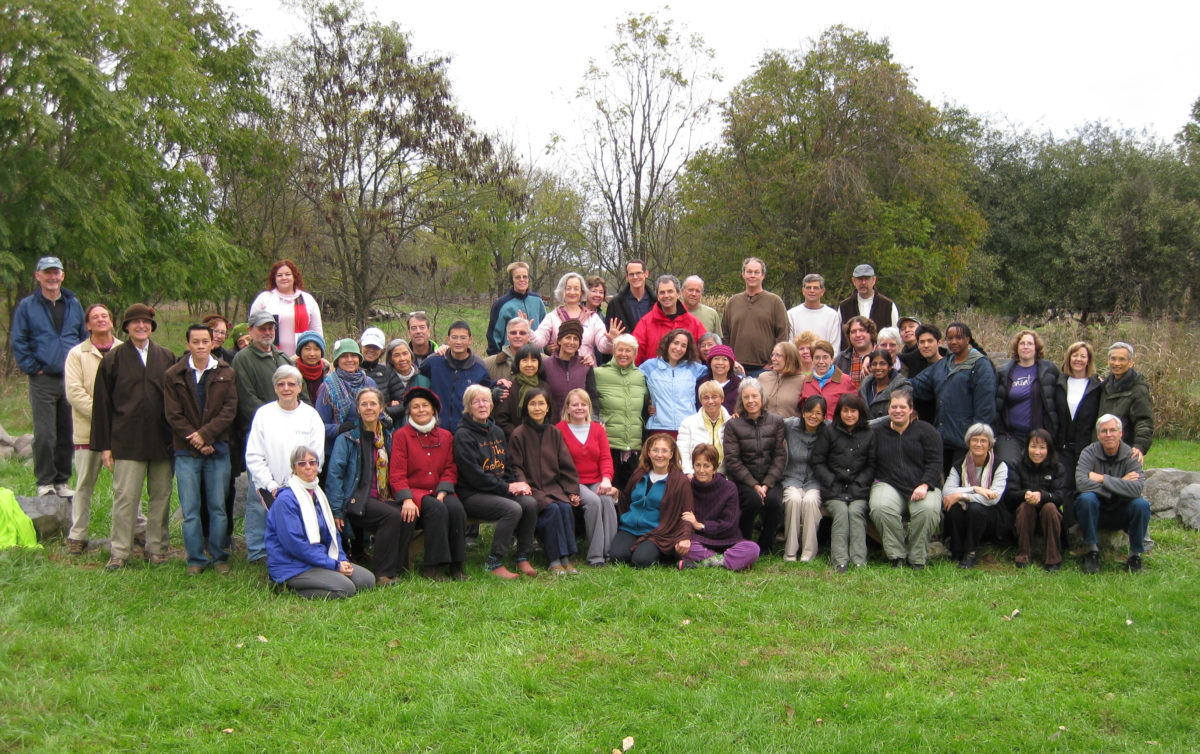
Embracing Our Pain
The message I’d like to repeat is: Don’t run away from the pain, sadness, or depression in you. Sometimes there’s a voice inside saying that if you go back to your pain, you will die. This voice may tell you not to trust the Sangha, and that this practice can only take you thus far. I name this destructive energy “ill will,” which is present in each of us. It prevents us from taking deep root into the Sangha soil. It threatens and prevents us from opening our hearts to our Sangha. It instills us with fear and doubts. We don’t need to argue with or listen to this voice. You know the mantra I’ve been sharing with my friends in the Sangha? If you hear this voice, take a few deep breaths and practice this mantra: “Okay. I will die. I accept dying. If I die in the Sangha’s arms, that’s the best place to die. If I die in the Buddha’s arms, what could be a better place to die?”
Regardless of what happens, we are committed to showing up at our Sangha. I have a Dharma brother who carries deep suffering and old traumas. In the past, he didn’t come to Sangha when emotions arose because he wasn’t able to drive. Now, when that happens, he can take a taxi to Sangha. He shows up. Sometimes when old trauma returns, we suddenly do not feel safe coming to the Sangha. I suggest to him pinning a note on his shirt, saying, “Dear Sangha, I need your support so that I may rest in the Sangha today,” when he comes and lies down in the Sangha.
At the end of the day, when we are tired, we go home and rest. We can lie in bed, relax, and drop all our self-images. I wish that my brothers and sisters can find that same rest, that same comfort in their Sangha. Sangha has to be a place where people can feel safe so that they can close their eyes, relax, and enjoy their breathing. When Sangha becomes a safe place, we’re not just talking about being cells in the Sangha body, we’re living it. Brotherhood and sisterhood come alive when we go through difficult as well as happy moments together. Sangha practice weaves threads of individual practitioners into a Sangha blanket, keeping everyone warm and comfortable.
That’s why Thu quit his job as a software developer and I quit my job as a biochemistry researcher, so that we could devote our lives to Sangha building. During the first year of the Mindfulness Practice Center of Fairfax, there were many days that the dana basket was empty. We lived on our savings. Our son Bao-Tich, who is now twenty, was still in kindergarten at the time. We wondered how the future of the MPCF would unfold. Many moments, we looked at each other and smiled, then looked up at Thay’s calligraphy on our altar: An Tru Trong Hien Tai (which means “Dwelling happily in the present moment”). We left it all in the hands of our ancestors and of the Sangha. We continued to share our lives and practice with friends near and far. We are happy.
Engaged Buddhism
MB: How do you define “engaged Buddhism,” and how do you practice it?
AH: Engaged Buddhism begins with being there for our pain. Not only our individual pain, but also our collective pain. We learn safe and gentle ways to pick up that baby of pain, to hold and soothe that baby with mindfulness. When our son was born, even though my mom had taught me how to hold him, and I had seen mothers holding their babies, I had to feel my way through. You have to hold the baby in your arms to bring alive that experience, not just intellectual understanding. With mindfulness and concentration, both mother and baby will be safe, comfortable, and happy.
For me, engaged Buddhism is like water. Water has no shape. When we put water in a square container, it takes on a square shape; in a round one, it has a round shape. The mindfulness practice center comes out of Thay’s brilliant idea to share the practice of mindfulness in a nonsectarian way. The Dharma takes no form, or any form. We would like to make the capital “B” of Buddhism into a small “b.” We do not need to have Buddha statues or burn incense. We do not need to bow to each other or use Buddhist terms. We learn to be present to the situation at hand and share the Dharma in a way that can help people feel safe, so that they can release tensions from their bodies and minds.
This explains why a Day of Mindfulness at MPCF begins with total body relaxation. People are so stressed. Guided meditation that is offered in the lying down position helps people to stop and connect with their bodies easily, especially for those who are new to mindfulness practice. Their minds become quiet and their hearts open. When we can be truly present, a new Dharma door will be open for that particular situation. So the format at MPCF comes from the needs of those who attend, not from us who facilitate.
Thay’s dream is to see a mindfulness practice center in every town and city. I have an image of mushrooms—centers sprouting up everywhere. Many Sangha brothers and sisters have already brought mindfulness into schools, prisons, and other places, without Buddhist form.
Once we are able to cradle the pain in our own hearts, understanding and compassion will guide us in every step along the path.

